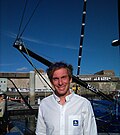Top Qs
Timeline
Chat
Perspective
Vendée Globe
Yacht race From Wikipedia, the free encyclopedia
Remove ads
The Vendée Globe is a single-handed (solo) non-stop, unassisted round the world yacht race.[1][2] The race was founded by Philippe Jeantot in 1989,[3] and since 1992 has taken place every four years. It is named after the Département of Vendée, in France, where the race starts and ends. The Vendée Globe is considered an extreme quest of individual endurance and the ultimate test in ocean racing.[4][5]
This article needs additional citations for verification. (November 2016) |
Remove ads
The race
Summarize
Perspective
History
The race was founded as "The Globe Challenge" in 1989 by French yachtsman Philippe Jeantot.[6] Jeantot had competed in the BOC Challenge in 1982–83 and 1986–87, winning the 60-foot class ("Class I") both times. The BOC Challenge was sailed in stages with sailors being given the chance to rest and repair their boats at ports around the world.[6]Unsatisfied with the race's format, he decided to set up a new round-the-world non-stop race, which he felt would be the ultimate challenge for single-handed sailors.[7]
The first race was run in 1989–90, and was won by Titouan Lamazou; Jeantot himself took part, and placed fourth.[8] The next race was in 1992–93; and it has since then been run every four years. The inaugural race included 11 Frenchmen, one South African (Bertie Reed) and one American (Mike Plant).[9]
Yachts

The race is open to monohull yachts conforming to the Open 60 class criteria. Prior to 2004, the race was also open to Open 50 boats. The Open classes are unrestricted in certain aspects, but a box rule governs parameters such as overall length, draught, appendages and stability, as well as numerous other safety features.
The race presents significant challenges; most notable are the severe wind and wave conditions in the Southern Ocean, the long unassisted duration of the race, and the fact that the course takes competitors far from the reach of any normal emergency response. A significant proportion of the entrants usually retire, and in the 1996–97 race Canadian Gerry Roufs was lost at sea.[10]
Course
The race starts and finishes in Les Sables-d'Olonne, in the Département of Vendée, in France; both Les Sables d’Olonne and the Vendée Conseil Général are official race sponsors.[11] The course is essentially a circumnavigation along the clipper route: from Les Sables d’Olonne, down the Atlantic Ocean to the Cape of Good Hope; then clockwise around Antarctica, keeping Cape Leeuwin and Cape Horn to port; then back to Les Sables d’Olonne.[12] The race generally covers approximately 24,000 nautical miles (44,000 km) and runs from November to February, timed to place the competitors in the Southern Ocean during the austral summer.[13]

Additional waypoints may be set in the sailing instructions for a particular race, to ensure safety relative to ice conditions, weather, etc.[14] There is also an exclusion zone set around Antarctica where competitors are prohibited to sail due to risk of icebergs.[15]
The competitors may stop at anchor, but may not draw alongside a quay or another vessel; they may receive no outside assistance, including customised weather or routing information. The only exception is that a competitor who has an early problem may return to the start for repairs and then restart the race, as long as the restart is within 10 days of the official start.
Qualification
To mitigate the risks, competitors are required to undergo medical and survival courses. They must also be able to demonstrate prior racing experience; either a completed single-handed trans-oceanic race or the completion of a previous Vendée Globe. The qualifying race must have been completed on the same boat as the one the sailor will race in the Vendée Globe; or the competitor must complete an additional trans-oceanic observation passage, of not less than 2,500 miles (4,000 km), at an average speed of at least 7 knots (13 km/h), with his or her boat.
Remove ads
Participation
Note * Some sailors' there dates of birth unknown
Remove ads
Results
Overall winners
Overall winners' times
Farthest distance covered in 24 hours
Winners' participation and equipment
Remove ads
See also
- IMOCA races
- The Barcelona World Race, a non-stop two handed race, currently run using the IMOCA 60 Class.
- Route du Rhum
- The Velux 5 Oceans Race, a stopping solo race, currently run using the IMOCA 60 Class previously known as the BOC Challenge, later as Around Alone.
- The Ocean Race, a stopping fully crewed race, currently using the Volvo Ocean 65 and IMOCA 60 class. Previously known as the Whitbread Round The World Race and the Volvo Ocean Race.
- Other races
- The Clipper Round the World Yacht Race, a stopping crewed race for amateur crews using the Clipper 70 Class.
- Jules Verne Trophy
- Oryx Quest
- Arkéa Ultim Challenge
- Former races including
- The Sunday Times Golden Globe Race, held in 1968–1969, the first round-the-world yacht race.
- The BT Global Challenge, was a race held every four years and followed the westward route.
- The Race, was a race held in 2000, involving multihulls.
- The Oryx Quest, held in 2005, starting from Qatar.
- Other speed sailing records
Remove ads
References
External links
Wikiwand - on
Seamless Wikipedia browsing. On steroids.
Remove ads














